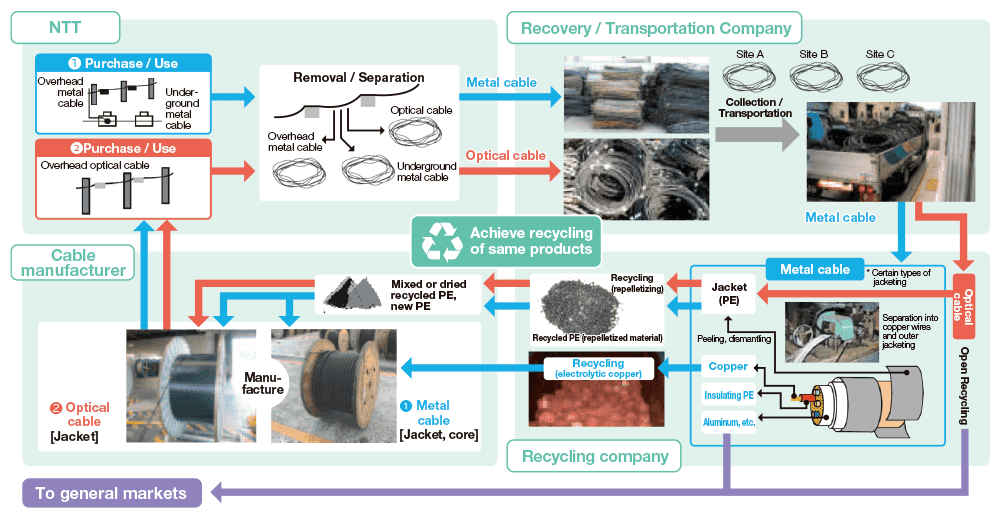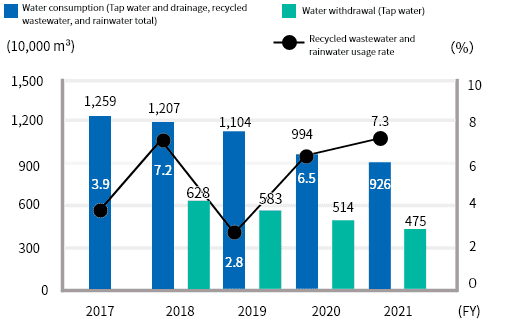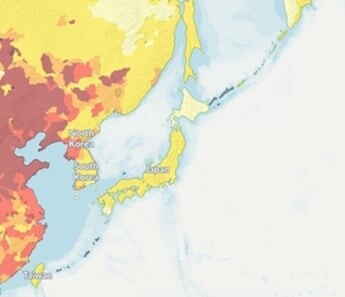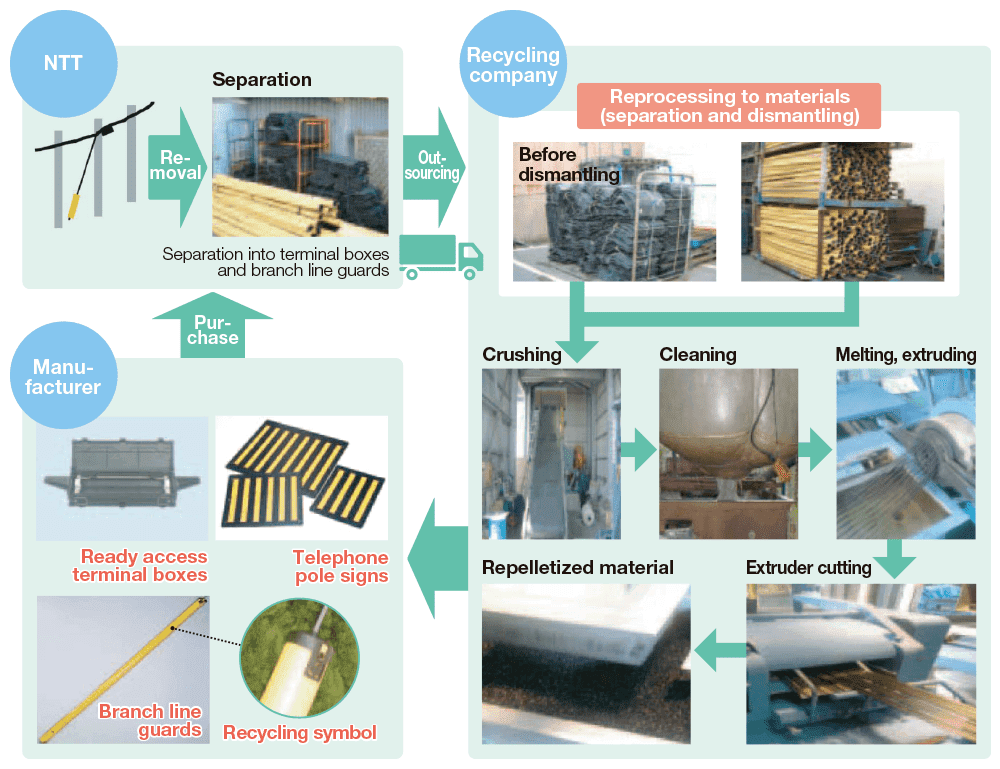Microsoft ends support for Internet Explorer on June 16, 2022.
We recommend using one of the browsers listed below.
- Microsoft Edge(Latest version)
- Mozilla Firefox(Latest version)
- Google Chrome(Latest version)
- Apple Safari(Latest version)
Please contact your browser provider for download and installation instructions.
Recycling and Reducing Environmental Impact
Organization for Implementation
Please see the following page:
Established under the Sustainability Committee described in the page on environmental management with the goal of achieving a waste recycling rate of 99% or more by 2030, the Green Innovation Committee works to identify the types and quantities of waste generated and investigate countermeasures to deal with it.
Targets and Performance
Increasing the reuse and recycling of communications equipment, mobile devices, and other technologies
(3) 2030: Waste recycling rate
Fiscal 2024 target: 98.2% (NTT Group-wide)
(4) Waste disposal (PCB) related legal violations
Fiscal 2024 target: 0 cases (NTT Group-wide)
Promoting the 3Rs (reduce, reuse, and recycle), working to reduce the amount of materials consumed by our business activities and reuse or recycle the resources that are consumed.
The NTT Group has established a target for achieving a 99% or higher recycling ratio of disposed waste generated by the NTT Group by fiscal 2030. We require a large amount of resources in order to sustain our business operations and provide various services including information communication. This is why we have set a target to contribute to both the avoidance of business continuity risks and achievement of closed loop recycling.
We recycled 98.4% of waste in fiscal 2023. We will continue promoting 3R with the aim of achieving our target of 99% or more. In addition, regarding dismantled telecommunications equipment, which makes up a part of that waste, we have achieved zero emissions (less than 1% final disposal of waste) for 20 consecutive years since fiscal 2004.

Reduction in plastics use and promotion of recycling Proper treatment, storage, and management of hazardous waste
Reduction in plastics use and promotion of recycling of plastics including telecommunications equipment, hazardous waste disposed of in compliance with laws and regulations, and ensure proper storage, management, and disposal.
The NTT Group is seeking to reduce the use of plastics and promoting recycling. For example, plastic parts of telecommunications equipment such as coverings for branch lines and ready access terminal boxes are used in a closed recycling system in which similar types of disposed covers are recycled into plastics to manufacture new products. We are also seeking to abolish the use of plastic packaging materials for devices used at customers' homes when connecting optical lines such as optical network units (ONU) and home gateway (HGW) units.
Appropriate and efficient management of water resources
The NTT Group is Reducing its Consumption of Tap Water, and Implementing Thorough Measures Against Leakages of Chemical Substances into Wastewater.
Due to the nature of the NTT Group's business, little water is consumed in our operations. NTT Group's water withdrawal of approx. 4.63 million m³ is less than 0.02% of the approx. 25.2 billion m³ (domestic and industrial water) consumed annually in Japan,1 and since this is dispersed throughout Japan we believe there are no water sources that would be significantly impacted by our water usage.
The NTT Group reduces its consumption of tap water by using recycled wastewater and rainwater. Research centers where we use chemical substances in our research activities implement individual measures against leakages of chemical substances into wastewater.

For example, at the Atsugi R&D Center, which carries out research on the physical properties of materials, we have installed equipment to treat chemical-infused waste liquid discharged by the laboratories. Furthermore, we regularly monitor the quality of this wastewater to confirm that it is within legal regulation values. The NTT Group has not been involved in any significant spills.
1From the Ministry of Land, Infrastructure, Transport and Tourism website. Actual water use in 2019 (based on water withdrawal) is approximately 78.5 billion m³/year
(approximately 14.8 billion m³ for domestic use, 10.3 billion m³ for industrial use, and 53.3 billion m³ for agricultural use)
Additionally, for the regional assessment of directly operated facilities at the installation and operation stages, we conducted a sampling survey by facility type of all NTT Group power generation facilities (solar and wind power) and telecommunications facilities (data centers and other telecommunications facilities) (tot. approx. 100,000 facilities).
With regards to water, some overseas data centers were in locations in regions with high water stress, but since the impact on nature is thought to be mainly due to water withdrawal, each operating company collects data on water intake and the surrounding water environment, and individually confirms that risks arising from these factors are minor.
 Image of Aqueduct
Image of Aqueduct
Remarks
Biodiversity risk: Using the biodiversity risk assessment tool (IBAT), it was assessed whether the location was in a Key Biodiversity Area (KBA).
Water Risk: Using the WRI Aqueduct 2019, it was assessed whether the location was in an area that has High or Very High Baseline Water Stress.
Major Efforts
Business Activity
Hazardous Waste
For NTT Group operations, hazardous waste as defined by law applies to asbestos contained in waste generated from construction work on relay stations, waste such as transformers and condensers containing PCBs, and lead batteries. These are disposed of appropriately and in compliance with the Waste Management and Public Cleansing Law (Waste Disposal Law) as well as other laws and regulations, and the NTT Group does not have a record of disposing of such waste in foreign countries. We also pay meticulous attention to the proper storage and management of equipment containing PCBs and PCB contaminated wastes, and dispose of them with safe and appropriate methods in conformity with the Law Concerning Special Measures Against PCB Waste.

Business Activity
Water restoration project in Chennai
Promotion of business transformation and DX
Promoting DX for business operations aims to increase work efficiency as well as implement initiatives for addressing environmental issues. The NTT Group is ramping up measures aimed at reducing the use of paper, such as charging for printed documents and changing invoices from envelopes to postal cards. In 2022, we achieved a reduction of approx. 79% compared to fiscal 2008. In fiscal 2023, we aim to reach a reduction of approx. 90% compared to fiscal 2008 levels by further advancing digitalization, coupled with the release of a shared Group IT system (billing). By fiscal 2025, we will achieve essentially zero use of paper including bills and order forms.
Paper Management and Recycling
We established a closed loop recycling system in 1999 to collect old telephone directories and recycle them to produce new ones.
We undertake numerical management for our use of virgin pulp. We are also working to reduce paper consumption of society through the use of ICT, which includes measures such as our Web billing service1.
1A service enabling customers to check their charges and usage at any time online.

Environment
Sustainability
NTT STORY
WEB media that thinks about the future with NTT










